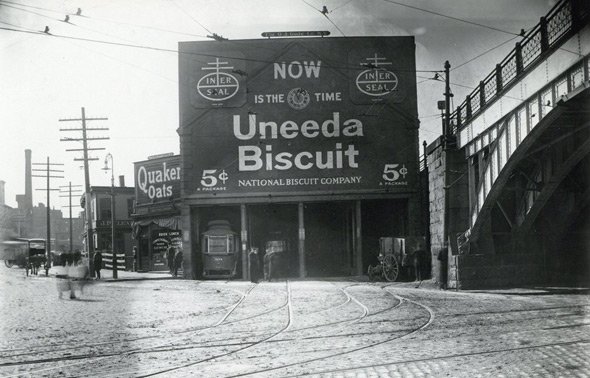Hey, there! Log in / Register
Who doesn't needa biscuit?
By adamg on Thu, 06/02/2016 - 10:29am

The folks at the Boston City Archives wonder if you can place this photo. See it larger.
Neighborhoods:
Topics:
Ad:

The folks at the Boston City Archives wonder if you can place this photo. See it larger.
Comments
Roxbury Crossing, circa 1900
Columbus Avenue on the left, the Boston Elevated Railway carhouse in the center, the New York, New Haven & Hartford Railroad bridge is on the right, with Tremont street cutting under the railroad bridge. The photographer is standing in front of Roxbury Station, which was on the Boston & Providence division of the railroad.
Overpasses are so 1950s. Let
Overpasses are so 1950s. Let's bring that down to street level.
Haha, Beat Me To It!
The first part of the Roxbury Crossing Carhouse opened about 1859. By the Civil War it had become the Metropolitan's main repair shop: everything from repainting to overhauls to even building new cars entirely from scratch! The Bartlett Street Shops assumed this role in 1886; but Roxbury Crossing continued to be an operating house. The oldest piece of Boston transit equipment still in existence, Car #724 (originally #804), was built here in 1884 and was retired by the MBTA in 1967 after a long passenger and work service career. It is currently awaiting full restoration at Seashore. [Type 3 #5164 holds the record for longest time on the fleet roster: it entered service in 1908 and was officially retired by the T in 2007.]
Among the more interesting events to happen at Roxbury Crossing was a stable fire one night in the late 1880s. A local Division Ten copper on the beat spotted the flames and helped free the horses. Naturally, they all ran off in every direction. A newspaper account joked that for one evening the horses were able to visit streets and lanes that had never seen horsecar service; a few horses even made it deep into Jamaica Plain!
Roxbury Crossing Carhouse closed in the early 1920s and the whole intersection and much of the surrounding neighborhood was leveled for a highway that never got built. The carhouse footprint is roughly where the Domino's is.
Everybody sing!
"The U-needa Biscuit in an air-tight sanitary package made the cracker barrel obsolete, obsolete!"
(Every time I see a Uneeda Biscuit tin in an antique store or an old print ad I immediately start to chant the lyrics to "Rock Island" - not the movie version, the first Broadway cast soundtrack - from "The Music Man". It's Pavlovian.)
"... Something Better Than A Uneeda Biscuit And A Cup Of Soup "
Thanks for playing, folks!
Thanks for playing, folks! This is indeed the Roxbury Crossing Carhouse in March of 1905
Hey this is a tad off topic
Hey this is a tad off topic but I am curious. See all those intersecting tracks? They don't look like they have switches on them. How did the trolleys get switched? Did the driver somehow have control?
There was some mechanism on
There was some mechanism on the car so the operator powered left, or let it glide right. Someone else can probably better explain the mechanics.
Too bad
we can't use those on the subway lines. They might be more reliable...
Powered switches in the Green Line Central Subway
were originally controlled by the approaching streetcar. As the operator came to the switch, they would either apply power and brake, or just power. Applying power and brake would create a momentary power surge that would be detected by the switch motor. This would cause the switch to throw to the "reverse" position. Applying just normal power wouldn't create the surge, and the switch would remain in the "normal" position.
This system worked very well until the Boeing LRVs were put into service. On those cars, the surge created by applying power and brake was very minimal. As such, the switch wouldn't throw and the operator would have to stop, get out, and push the corresponding button for the route they wanted.
The current Type 7 and Type 8 cars can remotely throw power switches through detection loops mounted in the track - it's linked to the automatic vehicle identification (AVI) equipment on the car. This system is mostly reliable, although operators still have to use the manual pushbuttons on occasion.
As another poster indicated, surface lines, especially for in-street trackage such as at Heath Street loop, use manual switches where the operator uses a long pole to physically move the switch.
The Simplest Switches Are Operated With A Long Metal Pole
The oldest and simplest switches are either spring-loaded (for example, two tracks that always merge into one), or else manually operated by using a long metal pole specialized for the task.
Power operated switches can be controlled either by automated wayside signaling systems, or by the trolley driver. For example: when a trolley is drawing current through its motors or a shunting resistor, it causes the switch to change. If the trolley just coasts through the switch not drawing current, it doesn't change.
The Toronto system has automatic electronic switches, but they don't work anymore, so a worker is stationed at certain intersections to operate the switches the old fashioned way. At other junctions, the trolley drivers have to get out and do it themselves.